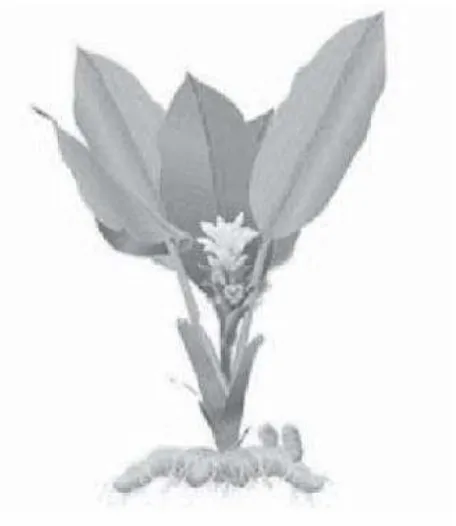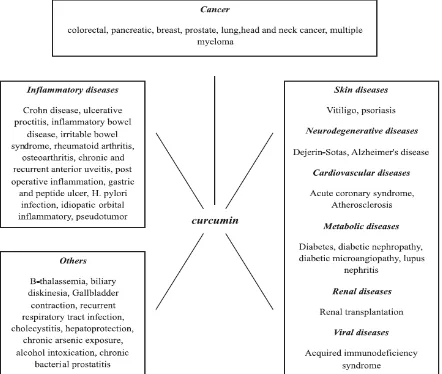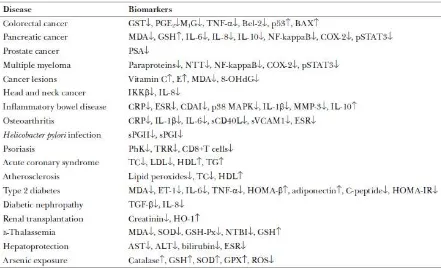NANOCURCUMINOID AS A LIVER PROTECTOR
Gontar Alamsyah SiregarDivision of Gastroentero-Hepatology, Department of Internal Medicine, Faculty of Medicine,
University of Sumatera Utara/ Adam Malik Hospital, Medan, Indonesia
Introduction
Liver is considered to be one of the most vital organs that functions as a centre of
metabolism of nutrients such as carbohydrates, proteins, lipids and excretion of waste
metabolites. Additionally, it is also handling the metabolism and excretion of drugs and other
xenobiotics from the body thereby providing protection against foreign substances by
detoxifying and eliminating them. The bile secreted by the liver has, among other things,
plays an important role in digestion (Kumar A, 2012).
Hepatic disease (Liver disease) is a term that affects the cells, tissues, structures, or
functions of the liver. Liver has a wide range of functions, including detoxification, protein
synthesis, and production of biochemical necessary for digestion and synthesis as well as
breakdown of small and complex molecules, many of which are necessary for normal vital
functions. The liver plays an astonishing array of vital functions in the maintenance,
performance and regulating homeostasis of the body. Therefore, maintenance of a healthy
liver is essential for the overall well being of an individual (Kumar A, 2012).
Medicine herbs are significant source of hepatoprotective drugs. Mono and
poly-herbal preparations have been used in various liver disorders. A drug having beneficial effect
on the liver is known as hepatoprotective drug. On the other hand, drugs having toxic affect
on the liver are better known as hepatotoxic drugs. Clinical research has also shown that
herbals have genuine utility in the treatment of liver diseases. The article deals with
investigate work done on herbals beneficial in liver and gallbladder ailments. There are
generally classified into 3 categories without any strict delineation amongst them.
- Anti hepatotoxic agents: these generally antagonize the effects of any hepatotoxins
causing hepatitis or any liver disease
- Hepatotropic agents: these generally support or promote the healing process of the
liver. In practice these two activities cannot be easily distinguished from each other.
- Hepatoprotective agents: these generally prevent various types of liver affections
prophilactically. In general any hepatoprotective agent can act as an anti hepatotoxic
The use of natural remedies for the treatment of liver diseases has a long history and
medicinal plants and their derivatives are still used all over the world in one form or the other
for this purpose. Scientific evaluation of plants has often shown that active principles in these
are responsible for therapeutic success. A large number of medicinal plants have been tested
and found to contain active principles with curative properties against a variety of diseases.
Liver protective plants contain a variety of chemical constituents like phenols, Coumarins,
Lignans, essential oil, monoterpenes, carotinoids, glycosides, flavonoids, organic acids,
lipids, alkaloids and xanthenes. Therefore a large number of plants and formulations have
been claimed to have hepatoprotective activity so the development of plant based
hepatoprotective drugs has been given importance in the global market. Some indigenous
plants that have hepatoprotective properties such as Curcuma longa, Silybum marianum,
Andrographic paniculata, Chamomile capitula, Coccinia grandis, Flacourtia indica, Wedelia
calendulacea, Annona squamosa, Prostechea michuacana, Ficus carica, Lepidium sativum,
Sargassum polycystum, Solanum nigrum, Swertia chirata, Phyllanthus emblica, Picr orhiza
kurroa, Azadirachta indica, Aegle marmelos, Cassia roxburghii, Orthosiphon stamineus,
Jatropha curcas, Foeniculum vulgare, Trigonella foenum graecum, Eclipta alba, Garcinia
mangostana Linn is reviewed (Kumar A, 2012). This review article has been presented to
discuss about curcuminoid as one of the most well known hepatoprotective agents and also
discuss about nanotechnology approaches (nanocurcuminoid) to enhance the bioavailability
of curcuminoid.
Curcuminoid
All curcuminoids are often referred to simply as “curcumin” even though turmeric
contains a variety of different curcuminoids. Commercial curcumin typically contains three
major curcuminoids: curcumin (curcumin I), demethoxycurcumin (curcumin II) and
bis-demethoxycurcumin (curcumin III). Commercial curcumin typically contains curcumin I
(~77%), curcumin II (~17%) and curcumin III (~3%) as its major components (Kashaw V, et
al, 2011).
Curcumin or diferuloylmethane is a yellow polyphenol extracted from the rhizome of
turmeric (Curcuma longa ), a plant grown in tropical Southeast Asia. For centuries, turmeric
has been used as a spice and coloring agent in Indian food, as well as a therapeutic agent in
traditional Indian medicine. Curcuma longa contains approximately 5% curcuminoids, 2%
vitamin C. The active constituent of Curcuma longa is Curcumin, which is the yellow
pigment of turmeric (Bisht S, et al, 2007).
Table 1. Molecular target of curcumin in human participants (Gupta et al. 2013).
↓ downregulation, ↑ upregulation, ALT alanine transaminase, AST aspartate transaminase, Bax Bel 2-associated X protein, Bel-2 B cell lymphoma-2, CDAI Crohn disease activity
index, COX-2 cyclooxygenase 2, CRP C- reactive protein, GSH glutathion, GST glutathion
S-transferase, GPX gluatthion peroxidase, HDL high density lipoprotein, LDL low density
lipoprotein, HOMA homeostasis model assessment, IL interleukin, MMP-3 matrix
metalloproteinase, NF-kappaB nuklear factor kappaB, PGE2 prostaglandin E2, pSTAT3 —
phosphorylated form of signal transducer and activator of transcription 3, SOD — superoxide
dismutase, ROS — reactive oxygene species, CD cluster of differentiation, ESR erythrocyte
sedimentation rate, ET1 endothelin 1, IR insulin resistance, MAPK nitrogen activated protein
kinase, MDA malondialdehyd, M1G pyrimido[1,2-α]purin-10(3H)-one, TNF-α tumor
necrosis factor-α, PSA prostate-specifi c antigen, NTT N-telopeptide of type 1 collagen,
8-OHdG 8-hydroxydeoxyguanosine, TC total cholesterol, TG triglyceride, PhK phosphorylase
kinase, TRR transferrin receptor.
Curcuminoid as a Liver Protector
Plant-derived polyphenols such as curcumin act as a potent therapeutic agent in the
treatment of chronic liver diseases. The hepatoprotective activity of the ethanol extract of
Curcuma longa was studied against paracetamol-induced liver damage in rats. At the dose of
increase in ALT and AST and ALP. Pretreatment of rats with the ethanolic extract of
Curcuma longa prior to paracetamol; dosing statistically lowered the three serum liver
enzyme activities. In those animals, which received the plant extract were found to be 156.7 ±
23.5 IU/L (ALT), 112.4 ± 35.2 IU/L (AST) and 135.5 ± 38.8 IU/L (ALP). These values are
significantly lower (P<0.05) than the values of the toxic control group and were similar
(P>0.05) to the control values. This current result suggests that ethanolic extract of Curcuma
longa has potent hepatoprotective effect against paracetamol induced liver damage in rats
(Kashaw V, et al, 2011; Kumar A, 2012).
Curcumin significantly repair and regenerated liver tissues of diabetic rats. These
finding demonstrated the potential role of curcumin as a novel therapeutic agent in liver
pathology of diabetic rats. Moreover, it also reduces the iron induced hepatic damage by
lowering lipid peroxidation in rats (Choudhary N, et al, 2012).
Studies in rats and mice have demonstrated that oral application of Curcuma (100
mg/kg bw) has a hepatoprotective effect from a variety of hepatotoxic insults, including
galactosamine and carbon tetrachloride, as shown by significant reduction of serum
transaminases. This hepatoprotective effect was confirmed by histopathological examination:
necrosis and vascular congestion were less profound in livers of the treated animals.
Furthermore an increase in binuclear hepatocytes was observed in the mid-zone, indicating
regeneration of hepatocytes. This hepatoprotective effect is considered mainly a result of its
antioxidant properties, as well as its ability to decrease the formation of pro-inflammatory
cytokines. Curcumin also reversed biliary hyperplasia, fatty changes, and necrosis induced by
aflatoxin in ducklings and dietary treatment of chicks with curcumin ameliorated the adverse
effects of aflatoxin B1 on the liver (EMA, 2013).
Subba et al reported when rats were fed with 0.1-0.5% curcuminoids a preventive
effect on deposition of cholesterol in the liver was observed, however, no effect on serum
lipids was found with a diet containing 0.2% curcuminoids. Yasni et al observed an inhibitive
effect on liver fatty acid synthase when rats were put on a diet containing 4% powdered C.
xanthorrhiza rhizome resulting in a decrease of the triglyceride content of the liver. In a
follow-up experiment it was observed that the essential oil from Curcuma xanthorrhiza had a
lowering effect on the hepathic triglyceride content and additionally that application of the
hexane fraction resulted in a lowering of the hepathic triglyceride content and the serum
triglyceride level (EMA, 2013).
However, its optimum pharmaceutical potential as nutraceutical has been limited by its lack
of aqueous solubility and poor bioavailability (low absorption, rapid metabolism and rapid
system elimination). To mitigate to above limitations, recently various nanostructured
watersoluble delivery systems were developed to increase the solubility and bioavailability of
curcumin (Anand B, et al, 2007; Yallapu MM, et al, 2012). Nanoparticle encapsulated
curcumin increased bioavailability when compared with the conventional curcumin, protect
from degradation, and increase its targeting capacity. Nanocurcumin enhance the clinical
efficacy by enabling aqueous dispersion (Choudhary N, et al, 2012).
Nanocurcuminoid (less than 50 nm in diameter) - to enhance the bioavailability of curcumin
In practice, only very low or undetectable levels of curcumin can be achieved in blood
by oral administration of curcumin. The low bioavailability of curcumin has been attributed
to its very low aqueous solubility, tendency to degrade in the gastroinenstinal tract in the
physiological environment, high rate of metabolism, and rapid systemic elimination. The low
bioavailability of curcumin has so far limited its medical use. It has been suggested that a
person is required to consume large doses (about 12-20g/day) of curcumin in order to achieve
its therapeutic effects on the human body (Dandekar PP, et al, 2010). That means one has to
swallow 24 to 40 curcumin capsules of 500mg each. These doses are considered to be too
high, and therefore, not feasible to be incorporated in clinical trials due to unbearable
after-taste to the palate, possibility of giving rise to nauseatic feeling and perceived toxicity issues.
Nanotechnology-based novel strategies are being aggressively explored worldwide to
enhance curcumin's bioavailability (up to 5.6-fold compared with that of native curcumin).
and reduce perceived toxicity as they offer several other additional benefits such as improved
cellular uptake, enhanced dissolution rates, excellent blood stability, controlled release
functions, multifunctional design, enhancement in its pharmacological activities (e.g.
antioxidant and antihepatoma activities) etc. This nanocurcumin is soluble in water and can
be readily absorbed into the bloodstream. Nanocurcumin was also given to mice, and did not
show any evidence of undesirable effects (Yen FL, et al, 2010; Bhadoriya SS, et al, 2011;
References
Anand P, Kunnumakkara AB, Newman RA, Aggarwal BB. Bioavailability of curcumin:
problems and promises. Mol Pharm. 2007;4:807–18.
Bhadoriya SS, Mangal A, Madoriya N, Dixit P. Bioavailability and bioactivity enhancement
of herbal drugs by “Nanotechnology”: a review. J Curr Pharm Res.2011;8(1):1-7. Bisht S, Feldmann G, Soni S, Ravi R, Karikar C, Maitra A, et al. Polymeric
nanoparticle-encapsulated curcumin ("nanocurcumin"): a novel strategy for human cancer therapy. J
Nanobiotechnology. 2007,5(3):1-18.
Choudhary N, Sekhon BS. Potential therapeutic effect of curcumin - an update. J Pharm
Educ Res. 2012;3(2): 64-71.
Dandekar PP, Jain R, Patil S, Dhumal R, Tiwari D, Sharma S, et al. Curcumin-Loaded
European Medicines Agency (EMA). Assessment report on Curcuma xanthorrhiza Roxb. (C.
xanthorrhiza D. Dietrich)., rhizoma. London: Committee on Herbal Medicinal Products
(HMPC); 2013. p.1-22.
Gupta SC, Patchva S, Aggarwal BB. Therapeutic roles of curcumin: lessons learned from
clinical trials. AAPS J. 2013;15:195–218.
Kashaw V, Nema AK, Agarwal A. Hepatoprotective Prospective Of Herbal Drugs and Their
Vesicular Carriers–A Review. Int J Res Pharm Biomed Sci. 2011;2(2):360-74.
Košťalovaa D, Bezakovab L, Račkovac L, Mošovskaa S, Šturdika E. Therapeutic potential
of curcumin in medicinal chemistry. Acta Chimica Slovaca . 2013;6(1):89-99.
Kumar A. A review on hepatoprotective herbal drugs. IJRPC 2012;2(1):92-102
Roy SR, Das S, Shil D, Dutta KN. Herbal protective agents: a review. World J Pharm
Res.2012;1(2):87-99
Yallapu MM, Jaggi M, Chauhan SC. Curcumin nanoformulations: a future nanomedicine for
cancer. Drug discovery today.2012;17:71-80.
Yen FL, Wu TH, Tzeng CW, Lin LT, Lin CC. Curcumin Nanoparticles Improve the
Physicochemical Properties of Curcumin and Effectively Enhance its Antioxidant and


